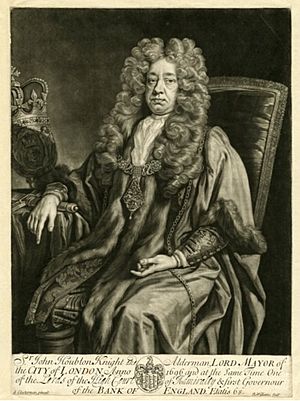John Houblon facts for kids
Quick facts for kids
Sir John Houblon
|
|
|---|---|
 |
|
| Governor of the Bank of England | |
| In office 1694–1697 |
|
| Preceded by | Office established |
| Succeeded by | William Scawen |
| Lord Mayor of London | |
| In office 1695–1696 |
|
| Preceded by | Thomas Lane |
| Succeeded by | Edward Clarke |
| Personal details | |
| Born | 13 March 1632 |
| Died | 10 January 1712 (aged 79) |
| Spouse |
Mary Jurin
(after 1660) |
| Children | 11 |
| Relatives |
|
Sir John Houblon (born March 13, 1632 – died January 10, 1712) was an important English merchant and banker. He made history by becoming the very first Governor of the Bank of England. This was from 1694 to 1697. He also served as the Lord Mayor of London in 1695.
Contents
Sir John Houblon's Early Life
John Houblon was born in London. He was the third son of James Houblon, a merchant. His mother was Mary Du Quesne. John had many brothers and sisters, twelve in total!
His Family's Background
The Houblon family were Huguenots. These were French Protestants who had to leave France because of their religion. They came from a city called Lille. John later became a leader in the French Protestant Church in London. This church was on Threadneedle Street.
John's younger brother, Abraham Houblon, also became a Governor of the Bank of England. This was from 1703 to 1705. His older brother, James Houblon, was a powerful merchant. He was also a Member of Parliament and a director of the Bank of England. Four more of his brothers were successful merchants too.
Sir John Houblon's Career
Sir John Houblon had a busy career in London. He held several important positions.
Roles in London City Government
In 1689, he became a Sheriff of the City of London. A sheriff helped keep law and order. From 1689 to 1712, he was an Alderman. An alderman was a senior member of the city council. He was also the Master of the Grocer's Company. This was a powerful trade group. In 1695, he became the Lord Mayor of London. This is the highest position in the City of London government.
Governor of the Bank of England
From 1694 to 1699, Sir John was a Lord Commissioner of the Admiralty. This meant he helped manage the Royal Navy. During this time, from 1694 to 1697, he became the first Governor of the Bank of England. The Bank of England is the central bank of the United Kingdom. It helps manage the country's money. After his term as Governor, he continued to be a director of the Bank of England from 1700. He was also a director of the New East India Company from 1700 to 1701. This company traded with countries in Asia.
Sir John Houblon on Banknotes
Sir John Houblon's picture was once on money! He appeared on the back of the Series E £50 notes. These notes were made by the Bank of England.
Why He Was Chosen
The notes were first printed in 1994. This was the year the Bank of England celebrated its 300th birthday. The design on the note showed Sir John Houblon. It also included a picture of his house on Threadneedle Street. This is the same street where the Bank of England building stands today.
New Banknotes
In 2011, a new £50 note was released. This new note featured James Watt and Matthew Boulton. They were famous inventors. The old note with Sir John Houblon stopped being valid money on April 30, 2014.
Sir John Houblon's Personal Life
In 1660, Sir John Houblon married Mary Jurin. She came from a Flemish Protestant family. They had five sons and six daughters. Sadly, only two of their sons lived longer than their father.
They lived in a beautiful house near Threadneedle Street in London. This house was later replaced by the Bank of England building. Sir John also owned a country house. This house was in High Ongar in Essex.

